The Ancestral Home
This Home was built by our grandfather Thomman
Karikkassery for his brother's widow in 1924, but since she chose not to move
from the main ancestral house, he moved into with his family. The design is
inspired by his Portuguese friend Mr. Carlos. And it was drawn by my grandfather
with help of senior Assaries (Architect-Carpenters as they were the civil
engineers and architects in those days ) It took five years to complete and was
the largest residence in Thiru Kochi state except for on or two palaces. At
present it is the residence of the youngest brother Norbert Karikkassery. This
is located on the Karthedom road at Malippuram, Vypeen Island. The main
ancestral house is on the other side of the Bunder canal and is the residence of
Sabu Karikkassery the grandson of our grandfather Thomman Karikkassery's elder
brother.
 The
western fore-court of the house. The mango tree in the foreground is famous for its huge mangoes
weighing over 6Kgs each, sour and meant only for cooking. We call it Ammini
manga as there is no similar mangoe to our knowledge. A favorite place to climb
to, when doctors come for immunization programs. Note the squat upper floor,
designed to be lower than the local temple, as the carpenters refused to build
higher than that. The hexagon shaped room was called pattom and the upper room
was the study and tuition room.
The
western fore-court of the house. The mango tree in the foreground is famous for its huge mangoes
weighing over 6Kgs each, sour and meant only for cooking. We call it Ammini
manga as there is no similar mangoe to our knowledge. A favorite place to climb
to, when doctors come for immunization programs. Note the squat upper floor,
designed to be lower than the local temple, as the carpenters refused to build
higher than that. The hexagon shaped room was called pattom and the upper room
was the study and tuition room.
The roof has 36 edges which is about the largest number in Kerala including ettu
kettu manas and carpenters used to travel from far and wide to come and take a
look at this strange house influenced by Portuguese design.
There used to be two large jasmine bushes in front on either side under which
there were rabbit warrens.
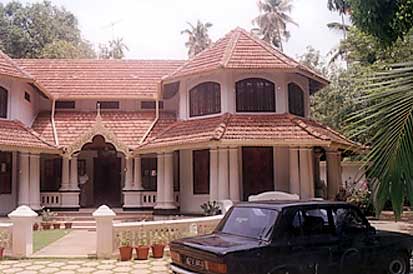 The
right side of the house with my father in the entrance verandah. There are a total of
32 pillars supporting the verandah roof. In the enclosed fore-court we used to have
smooth round pebbles brought from the Periar river at Alwaye.
The
right side of the house with my father in the entrance verandah. There are a total of
32 pillars supporting the verandah roof. In the enclosed fore-court we used to have
smooth round pebbles brought from the Periar river at Alwaye.
I remember that when we go to
our summer house on the Sivarathri Temple Road in Thottekattukara, for the
school holidays. We used to
collect these pebbles from the river every morning during our bathe,
and then use them to play with our cousins who would have also come to their
summer homes alongside ours. We used to take back our winnings in sacks, and pour it
all out in the fore-court of this house, so that the entire surface became
filled. My sister Ammini used to be specially proficient at this game and bring
back a lot every summer holiday that we spent in Alwaye.
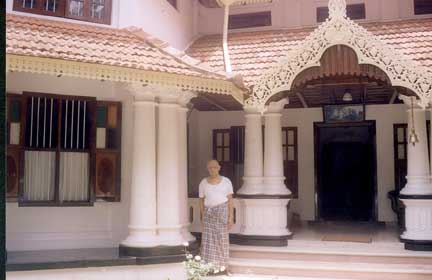 My
father George Karikkassery, who followed his father as panchayath president
stands on lower verandah. These old houses had a two level verandah as
protection during the monsoon. The wooden fascia of the house with cherubs and
bunches of grapes was drawn by my grandfather. It used to be colorfully painted.
There used to be a carved oval table in front of the door to prevent cows from
charging through the house when they are brought in from grazing.
My
father George Karikkassery, who followed his father as panchayath president
stands on lower verandah. These old houses had a two level verandah as
protection during the monsoon. The wooden fascia of the house with cherubs and
bunches of grapes was drawn by my grandfather. It used to be colorfully painted.
There used to be a carved oval table in front of the door to prevent cows from
charging through the house when they are brought in from grazing.
Thambi, our
major-domo used to make them all run in through the main gate and some used to run straight down the
path, and in through the front door, through the sitting room, the prayer hall,
the larger dining room and sometime even the kitchen, upsetting all of us. It
was almost like an avalanche with the large brown Jersey cow skidding on the
polished floor, knocking over small tables and chairs and a source of merriment
for the children. The cow of course used to totally ignore the shouted commands
of my mother, aunties and other assorted elders.
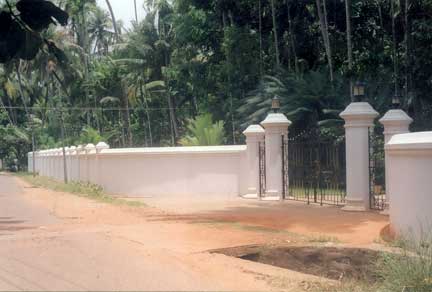 This
is a new wall and gate built by Nobby after the old one fell down as the foundation
had deteriorated. There was an Athani (resting bench for travelers) built
beside the road where my grandfather used to site in the evenings, meet and
chat with the village elders. Many decisions concerning the village would be
taken here rather than in the panchayath, of which he was the founder president.
It was not re-built after it cracked because it would now become a different
sort of haunt in front of the house. The wall is the longest in the village
encompassing the entire 3.5 acres of the house compound.
This
is a new wall and gate built by Nobby after the old one fell down as the foundation
had deteriorated. There was an Athani (resting bench for travelers) built
beside the road where my grandfather used to site in the evenings, meet and
chat with the village elders. Many decisions concerning the village would be
taken here rather than in the panchayath, of which he was the founder president.
It was not re-built after it cracked because it would now become a different
sort of haunt in front of the house. The wall is the longest in the village
encompassing the entire 3.5 acres of the house compound.
In the old days only the front had a wall,
the rest was made of fencing decorated with coconut palm fronds, perennially
being renovated by two lazy experts. My dad got fed up when they became too old
to do it, and began building the wall which was completed by Nobby.
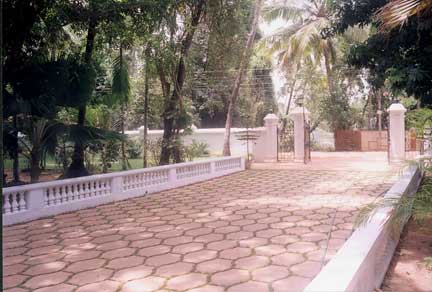 The
drive-way
The
drive-way
This where the cow would pick up speed in
the old days and be too fast to turn aside and go on through the front door. The
paving stones were laid by Nobby after the death of the woman who used to sweep
the ground, leaving a beautiful pattern in the fine white river sand from her
spread broom. there was art in her sweeping.
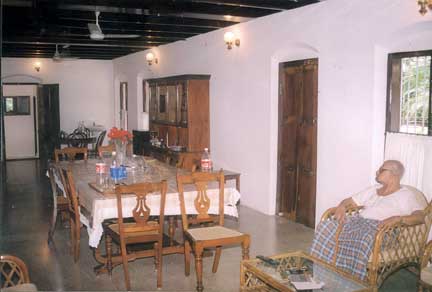 My
father, looks at the re-arrangement carried out by Nobby.
There was an old wooden Arra (granary) separating the main dining room from the
smaller dining room with a gloomy pathway beside it, where they used to hang
bunches of bananas to ripen. A place so gloomy, and sometimes crossed by rats
residing the ventilation area below the Are. We children, used to be scared
to pass through it into the small dining room and would rather go through the
verandah room. Since the paddy cultivation was reduced, there was no longer any
need for the Arra and the occasional rat below it, so it was removed providing
for a 40ft dining area cum TV viewing area. The door that can be seen is an exit
to the bathing pond. There were five ponds. A large bathing one with a
submerged wooden stage in the centre, for children to stand on, a drinking water
pond at the back near the kitchen, a dipping pond for wetting the rice
seedling bundles for sprouting. And for washing the cows and dogs. two
smaller ponds in the Gents and Ladies lavatory area. I used to remember the
in-out board to let others know that you are somewhere in that fenced compound
area sitting on the two planks placed over a pit (covered every evening by workers for
the next day's load. After one pit is fully covered up, the next would be dug.
Great fertilizer!) The ponds were for washing our behinds.
My
father, looks at the re-arrangement carried out by Nobby.
There was an old wooden Arra (granary) separating the main dining room from the
smaller dining room with a gloomy pathway beside it, where they used to hang
bunches of bananas to ripen. A place so gloomy, and sometimes crossed by rats
residing the ventilation area below the Are. We children, used to be scared
to pass through it into the small dining room and would rather go through the
verandah room. Since the paddy cultivation was reduced, there was no longer any
need for the Arra and the occasional rat below it, so it was removed providing
for a 40ft dining area cum TV viewing area. The door that can be seen is an exit
to the bathing pond. There were five ponds. A large bathing one with a
submerged wooden stage in the centre, for children to stand on, a drinking water
pond at the back near the kitchen, a dipping pond for wetting the rice
seedling bundles for sprouting. And for washing the cows and dogs. two
smaller ponds in the Gents and Ladies lavatory area. I used to remember the
in-out board to let others know that you are somewhere in that fenced compound
area sitting on the two planks placed over a pit (covered every evening by workers for
the next day's load. After one pit is fully covered up, the next would be dug.
Great fertilizer!) The ponds were for washing our behinds.

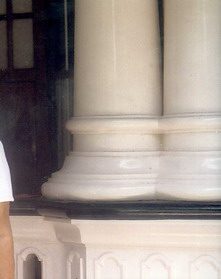 Detail
of the external doors and pillars.
Detail
of the external doors and pillars.
All the external doors and windows were
carved with this type of design, the windows having a oval shape on both sides.
The pillars had a slight taper towards the
top, we used to get caned for writing our names on it in black lead pencil.
More pictures will be put later on
 The
western fore-court of the house. The mango tree in the foreground is famous for its huge mangoes
weighing over 6Kgs each, sour and meant only for cooking. We call it Ammini
manga as there is no similar mangoe to our knowledge. A favorite place to climb
to, when doctors come for immunization programs. Note the squat upper floor,
designed to be lower than the local temple, as the carpenters refused to build
higher than that. The hexagon shaped room was called pattom and the upper room
was the study and tuition room.
The
western fore-court of the house. The mango tree in the foreground is famous for its huge mangoes
weighing over 6Kgs each, sour and meant only for cooking. We call it Ammini
manga as there is no similar mangoe to our knowledge. A favorite place to climb
to, when doctors come for immunization programs. Note the squat upper floor,
designed to be lower than the local temple, as the carpenters refused to build
higher than that. The hexagon shaped room was called pattom and the upper room
was the study and tuition room. The
right side of the house with my father in the entrance verandah. There are a total of
32 pillars supporting the verandah roof. In the enclosed fore-court we used to have
smooth round pebbles brought from the Periar river at Alwaye.
The
right side of the house with my father in the entrance verandah. There are a total of
32 pillars supporting the verandah roof. In the enclosed fore-court we used to have
smooth round pebbles brought from the Periar river at Alwaye.  Detail
of the external doors and pillars.
Detail
of the external doors and pillars.